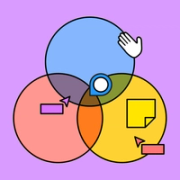
Put your app to the test using the 10 usability heuristics. FigJam’s dedicated heuristic review template makes in-depth evaluation a pleasure to perform.

Evaluate existing designs, identify issues, and come up with solutions as a team on FigJam’s shared workspace.

Make concrete progress toward a seamless application interface when you organize and conduct your app assessments using FigJam’s heuristic review template.
Find fixes: Enhance your application’s usability by easily identifying issues, then solving them.
Collect critiques: Gather valuable feedback according to a streamlined, consistent system.
Reallocate resources: Spend your time and money wisely by utilizing in-house resources and moving swiftly through dev stages.
 numbers one through five" width="540" height="540" />
numbers one through five" width="540" height="540" />

Perform your evaluation with the entire team present, using FigJam’s integrated widgets. Everyone can drop Lil’ Notes, add a Graphic Aid or two, and insert a Table to better categorize information. Reference your heuristic eval anytime, and pick out the precise piece of information you need.
Evaluate your application with specificity and skill using FigJam’s heuristic evaluation report example. Carry that momentum into your other processes with more Community-built templates.

Nail down the right next step.

Spread the word to guests around the globe.

Discover ready-made solutions to any problem you might face.
Heuristic evaluation is the practice of examining the user experience of a website or application according to the ten principles developed by Jakob Nielsen and Rolf Molich. These principles are structured to reveal usability problems that the development team may have missed during the build.
The reason why heuristic evaluation is important is that web designers can’t always see from the opposite perspective—they can be blinded by their own expertise and familiarity with the project. Examining a web project from the user’s perspective allows you to pinpoint every problem before launch and deliver a more seamless experience from the get-go.
If you’re not sure how to perform heuristic evaluation, here are the steps to follow:
1. Gather your team of evaluators
2. Decide which scenarios you’ll be examining—all 10 heuristics or just a few
3. Navigate through the product, grading each of the principles along a numbered scale
4. Meet to discuss the issues you’ve identified and strategize about how to solve them
As for when to conduct heuristic evaluation, you’ll want to initiate the process near the end of the development phase but well before your launch date so you have plenty of time to reevaluate and make necessary changes.
The main difference is who performs the deep dive: heuristic evaluation is a process performed by internal team members ahead of the launch of a website or application, whereas usability testing is performed by external potential users who are given specific tasks to complete.
Put another way, heuristic evaluation requires developers to approach their work from another angle, while usability testing allows them to see how their users will approach their work.